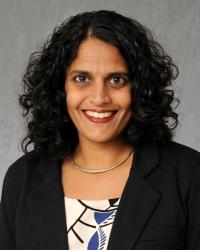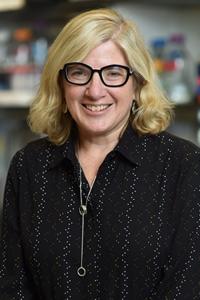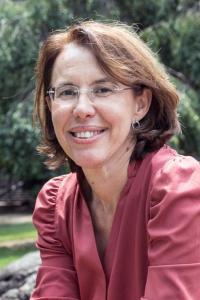
Grant Terminations Undermine Relationships Between Researchers and the Communities They Serve
Ami Zota got notice that one of her grants was being terminated by the National Institutes of Health (NIH) on March 10. It happened to be one of the biggest days of the year for the Department of Environmental Health Sciences at Columbia Mailman School—the annual Granville H. Sewell Distinguished Lecture. After the excitement of the presentation, Zota, an associate professor in the department, came home to an email saying funding for her grant was ending effective immediately.
There had been rumors about terminations, but that didn’t make the news any less hurtful. Her canceled grant—an R01, the kind of NIH grant given to a single investigator—was an important addition to the Taking Stock Study, a larger research project to understand and mitigate racial and ethnic disparities stemming from chemical exposures in personal care products. Only just approved last year, the funding supported a study designed by scientists and community partners in Black and Latino communities in Los Angeles to improve the way individualized findings on chemicals of concern—both in their bodies and their products—are conveyed to participants, in such a way that empowers them to protect their health.
Obviously, grant terminations like Zota’s affect the investigator, their research team, and the larger funding of the school and university. But they also have a negative impact on community partners, and on study participants who often volunteer their time and share medical and environmental samples with researchers. These relationships take trust. But according to researchers, the recent terminations jeopardize the bonds between researchers and community members that are critical to moving the needle on public health goals. Moreover, the abrupt nature of the terminations leaves scientists and their partners scrambling to find a new way to work in a drastically altered funding landscape.
“I’m proud of all the careful work we’ve done to document how hundreds of products are being used by these communities, along with their potential health risks. We worked hard to engender trust by making study participants feel invested. But the sudden termination of our grant has damaged relationships with our grassroots partners, some of whom now feel betrayed,” explains Zota.
Could Investments in COMMUNITY Research Be Wasted?
Work for what would become the COMMUNITY research collaborative began in 2021 when Epidemiology Professor Mary Beth Terry wrote a grant proposal with colleagues across the city in response to a request for applications from the National Institute on Minority Health and Health Disparities, calling for interdisciplinary science to address health disparities. Eleven centers in states from Alabama to Minnesota funded, including the COMMUNITY Center at Columbia Mailman.
COMMUNITY brought together multiple academic and community partners to test interventions—medication management, sleep quality, and colorectal screening—to prevent multiple chronic diseases. It also funded early career investigators and community partners to pursue their own research into upstream drivers of health disparities. “The grant was allowing us to do what the community always wanted us to do—to focus on more than one disease at a time,” Terry says.
When it was terminated, this multi-million-dollar P50 Center grant was in the middle of its fourth year of a five-year funding period. Recruitment was still ongoing, so to lose a center of this scope means that much of the work will still be incomplete. “To end this grant abruptly means that the investment the NIH made in our study sets progress towards scalable prevention interventions back dramatically. It is also financially inefficient given that the first three and a half years were already supported,” Terry observes.
Worse still, the termination breaks apart a large collaboration that had been carefully assembled over the last four years. “It’s not easy to get a lot of people to play in the sandbox, so when you have effective partnerships like we did in COMMUNITY, they are devastating to lose,” Terry says. “On top of that, there are all the people who volunteered their time to participate in these studies. We told them we’d give them answers, and now we can’t.”
An Ethical Obligation to Study Participants
As part of the Columbia University Northern Plains Superfund Research Program, researchers across multiple western states collected thousands of water samples from study participants in rural areas dependent on well water. The goal was to analyze water for evidence of arsenic and uranium. Known as the “king of poisons,” arsenic is carcinogenic and can lead to diabetes, cardiovascular disease, kidney disease, as well as cognitive impairment.
The study was in year three of its five-year P42 center grant when the termination hit. Researchers were actively analyzing water samples, linking contamination data with health outcomes, and developing treatment systems—work that now hangs in the balance.
“These families trusted us to go into their houses to collect a water sample so they could learn if their water is safe or not,” says Ana Navas-Acien, the center’s principal investigator and Leon Hess Professor and Chair of Environmental Health Sciences. “Now we have the samples, but we don’t have the resources to complete the laboratory work.” For the samples already analyzed, she stresses researchers have an ethical duty to share results despite the funding loss: “We have an obligation to let them know what we found. We are prioritizing what we need to do to maintain the trust of the communities.” Untested samples face disposal unless the grant is restored or additional funding can be secured.
The Best Science in the World—Now What?
Until recently, the NIH grant process was as predictable as clockwork—from application due dates, grant reviews, notices of award, progress reports, and competitive renewals. A notice of award assured multiple years of funding. Terminations happened only rarely, only ever due to a problem specific to the study in question, never due to allegations against the larger institution. Over the decades, generous indirect costs supported the development of a robust research infrastructure, including state-of-the-art labs. This system—and the NIH’s sizable grants budget—made the U.S. the leader for biomedical research for more than 70 years.
When she earned her PhD in 2005, Navas-Acien considered two job offers: one in her native Spain and another in the U.S. Despite a lack of family ties here, she chose the U.S. “I knew that what I could achieve would be so much more influential in terms of discoveries and impact to society if I did it here. People want to do good science, and the U.S. has been the country in the world where the best science was done,” she says.
Now, with the sudden terminations in March and other disruptions to federal funding, researchers must consider new ways to support their research, such as foundations and local, state, and international organizations. Following the terminations, the university asked investigators to prepare a plan to complete their projects in an orderly way, with funding provided to support that process. In addition, donors have made over one million dollars available as part of a Research Response Fund to Columbia Mailman, but it will take substantially more resources to bridge the funding gap.
While their terminated research projects will likely not continue, the researchers are resolute that they will continue to pursue their research goals.
Ami Zota has built her career on science in the service of environmental justice. She has several nonfederal grants and is looking for more. One priority is Agents of Change, the mentorship and training program she founded in 2019 to empower emerging leaders in environmental health sciences from backgrounds often neglected in science and academia. “I'm not going to give up on this work,” she says.





